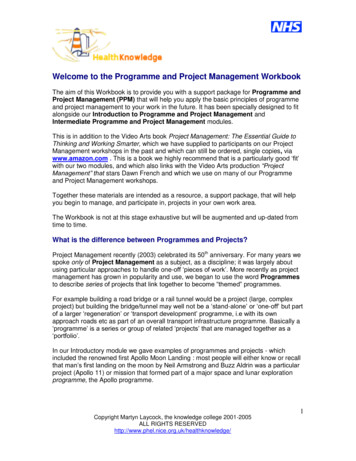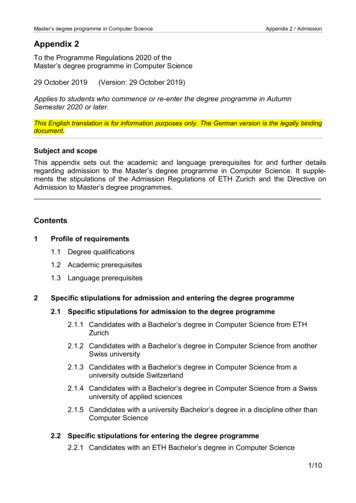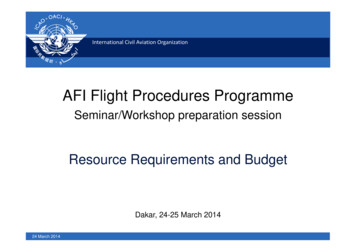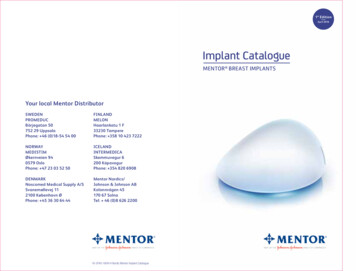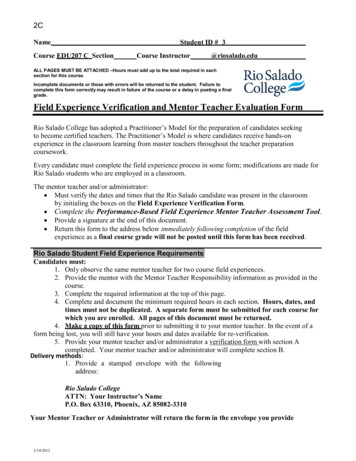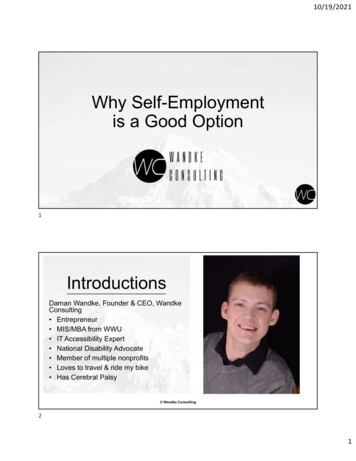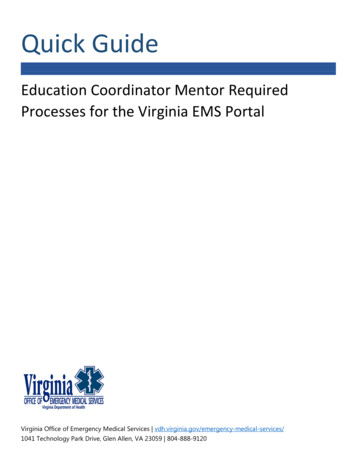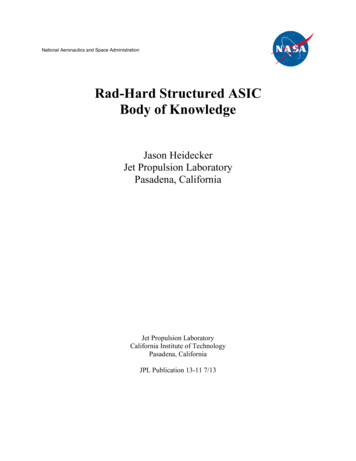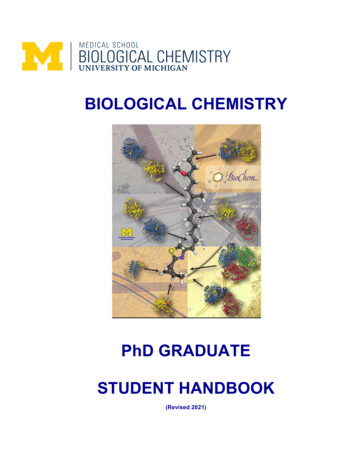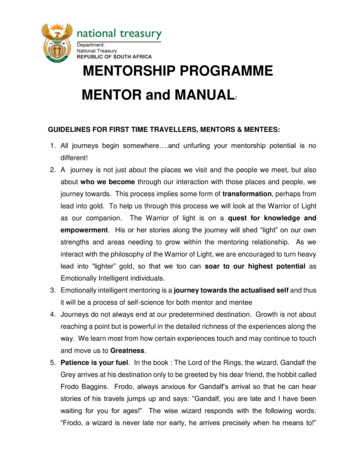
Transcription
MENTORSHIP PROGRAMMEMENTOR and MANUAL:GUIDELINES FOR FIRST TIME TRAVELLERS, MENTORS & MENTEES:1. All journeys begin somewhere .and unfurling your mentorship potential is nodifferent!2. A journey is not just about the places we visit and the people we meet, but alsoabout who we become through our interaction with those places and people, wejourney towards. This process implies some form of transformation, perhaps fromlead into gold. To help us through this process we will look at the Warrior of Lightas our companion.The Warrior of light is on a quest for knowledge andempowerment. His or her stories along the journey will shed “light” on our ownstrengths and areas needing to grow within the mentoring relationship. As weinteract with the philosophy of the Warrior of Light, we are encouraged to turn heavylead into “lighter” gold, so that we too can soar to our highest potential asEmotionally Intelligent individuals.3. Emotionally intelligent mentoring is a journey towards the actualised self and thusit will be a process of self-science for both mentor and mentee4. Journeys do not always end at our predetermined destination. Growth is not aboutreaching a point but is powerful in the detailed richness of the experiences along theway. We learn most from how certain experiences touch and may continue to touchand move us to Greatness.5. Patience is your fuel. In the book : The Lord of the Rings, the wizard, Gandalf theGrey arrives at his destination only to be greeted by his dear friend, the hobbit calledFrodo Baggins. Frodo, always anxious for Gandalf’s arrival so that he can hearstories of his travels jumps up and says: “Gandalf, you are late and I have beenwaiting for you for ages!” The wise wizard responds with the following words:“Frodo, a wizard is never late nor early, he arrives precisely when he means to!”
This is an excellent reminder that all journeys take place over a period of time.Depending on the speed at which you travel, the terrain you must cross and theresources you have equipped yourself with, everyone gets there precisely when hemeans to and more importantly when he needs to!6. There is a difference between chronological time and emotional time requiredfor growth. These two concepts are not interchangeable! Anyone who expectsthis is setting themselves up to fail! Growth unfolds at it’s own pace and in uniqueways for different people. Why do rose bushes that are planted alongside eachother produce rose buds that unfurl at different times?7. Don’t expect that fellow travellers will experience the same emotions and frustrationsand be touched in the same way that you may be by certain landscapes .stopcomparing yourself and validating your experiences through other people’saffirmation.8. The stories at the start of each module serves as a metaphor for that particular partof the journey. Read them, play with them, write them out and place them whereyou can be reminded of your particular strength, challenge, learning curve, or simplyto be inspired by the imagery it evokes within you.9. Above all.remember Rule no 6.don’t take yourself so seriously that you forgetto risk new behaviours for fear of failure and judgement. Growth takes courage andcourage does not imply the absence of fear but rather attempting new things despitebeing nervous and fearful!10. SO WHAT IS MENTORING EXACTLY?11. Mentoring is a process of deploying experienced individual to provide guidance andadvice that will help to develop the careers of mentees allocated to them.12. For the purpose of this programme, mentoring will defined as:“A process of deploying experienced individuals to provide guidance andadvice that will help to develop the careers of mentees allocated to them.Mentoring is defined in a number of ways:A mentoring relationship is a relationship between two or more people,(whether formalised or not) where the relationship has a specific purpose. Therelationship is reciprocal and both parties benefit, albeit in different ways. Thementor-mentee relationship is dynamic with different stages or phases. Each
mentor-mentee relationship is unique although there may be certain ips.Thisrelationshiptranscends duty and obligation and often involves coaching, networking,sponsoring and career counselling”. (Meyer, M 2006).From the above definition it is evident that mentoring is a learning partnership that isco-created by two parties, namely the mentor and the mentee.This definition highlights the following very important characteristics: The mentoring relationship is dynamic, i.e. as it is focused on growth andknowledge transfer. It is a reciprocal relationship which suggests that commitment to therelationship comes from both sides as does the growth. It is a learningpartnership in which both parties are learning and growing. The relationship takes place within the context of the work environment. The mentor is the wise career incumbent. The mentor is focused on helping the mentee develop his or her potential. The mentee is the less experienced but has development potential. The mentor is not the direct supervisor of the mentee, but a third party suchas a manager in a different department. The mentee is developed in some specified capacity in other words there mustbe a clear purpose and focus for development through mentoring. Mentoring is not about being sponsored for promotion.The role of the mentor is not merely to provide guidance and advice on how toaccomplish certain tasks skilfully. The mentor’s primary role is twofold: To provide career development behaviours such as coaching, providingchallenging assignments and fostering the mentee’s visibility. To provide psychosocial support such as counselling, support and rolemodelling.The role of the mentee is to assume responsibility for his or her own growth and tosee feedback from the mentor as an opportunity to grow and improve their skills.
For mentoring to work the mentor co-creates a learning partnership with a mentee.Goodman (2004) defines a mentee as:“a person who takes charge of their own development and sees real value in learningfrom others”Thus Mentoring is the transfer and exchange of information between a mentor and amentee as they develop a long-term relationship. Clearly the focus of mentoring isthe transfer of knowledge throughout the organisation.13.WHAT ARE THE BENEFITS OF MENTORING?Mentoring is a very powerful tool and can have many benefits, as an intervention withinthe Public Finance Management sector. For this reason it requires much planning, effortand energy which should all be directed towards attaining specific benefits for yourorganisation. Some typical benefits of implementing a mentoring programme are: It can be used for leadership and management development.JackWalsch, as one of the most influential CEO’s and the world of leadershiphas on many occasion stated that his most important role as a leader is tomentor talent and that this consumes about 70% of his time. It supports and reinforces training and skills development interventions Mentoring, when combined with training increases a manager’sproductivity by 88% according to the American society for Training &Development. It facilitates learnerships by appointing workplace mentors and coaches tosupport learners with the application of skills after training It aids in the induction and orientation of new employees or managers It assists with career development It promotes succession planning and skills transfer It promotes teamwork and sound working relationships It assists with the implementation of performance management It contributes to job satisfaction It accelerates employment equity It builds competence within the organisation
It contributes to employee retention. Business week reports that over 35%of employees who are not mentored within the first 12 months after theyare hired are actively looking for a job!(career systems internationals,2003). According to Louis Harris & associates only 16% of those withmentors expect to seek other employment (Sukiennik,2004) It harnesses the full potential and talents of employees It promotes a learning culture in an organisation It helps a company to achieve its business objectivesFigure 1. Benefits to all partiesMentorsMenteesGetmoreopportunities to applyOrganisationLearnfromexperienced peopleleadership skillsPooloftalentforprofessional&management jobs iveskillscareer progressiontransferSelf-fulfilment to seeDisadvantagedFuturementees performemployeesLearn from hapedAdapt quicker in newSupports fast trackingjobs & rolesImproved credibilityDevelop networksImage of organisationis enhancedExpand opportunitiesEnhancedMorefor dialogue at allinterpersonal tsorganisationEnhance professionaldevelopment&
14. IS THERE A DIFFERENCE BETWEEN MENTORING AND COACHING?According to Meyer & Fourie (2006), Coaching can be defined as:“The systematically planned and direct guidance of an individual or group ofindividuals by a coach to learn and develop specific skills that are applied andimplementedin the workplace, and therefore translates directly to clearly defined performanceoutcomes that are achieved over a short period of time” . From this definition it isclear that coaching is a form of on-the-job training. In order to be a good mentor, onemust already be a good coach. Please refer to table 2 for the distinctions betweenmentoring and coaching.Figure 2. Differences between Coaching & MentoringCOACHINGMENTORINGProvides day to day skills to be usedProvideson the jobdevelopment2 parties are involved, i.e. the3 parties are involved, i.e. manager,manager and the employeeemployee & mentorCoach is usually the direct lineThe mentor is an independent third formanceMaintained by development agreementappraisalsDriven by individual coachesDriven by steering committeeUsually no policy framework forGuided by policy frameworkcoachingCoaches are appointedMentors are nominated or are volunteersOccurs on the jobOccurs off the jobIs training focusedIs development focusedRelationships are formed sue toRelationships are formed via matchingsupervisory roleGoals,objectives&tasksarenormally not documented (informal)Goals, objectives & tasks are documented
Job outputs are measuredDevelopmental outputs & the overallmentoring process can be measuredUsedtodevelopindividualUsed for a variety of reasons, e.g. careercompetencemanagement, fast-tracking, equityThe relationship continues as longOnce goals are achieved, the formalas there is a supervisory-employeerelationship is terminatedrelationshipFrom this list of differences one can summarise the core difference betweenmentoring and coaching in the following:“Coaching aims to achieve and empower performance today whereasmentoring aims to achieve performance and empowerment tomorrow”15. THE ORIGINS OF MENTORING: AN AGE-OLD TRADITION:Much of the literature on the subject of mentoring suggests that the discipline ofmentoring originated from a character in Homer’s Odyssey called Mentor. Mentor wasactually the goddess Athene in disguise and her role was to accompany and guide theyoung man Telemachus on a quest to find his father, Odysseus.However further research takes us back to 1689 in France, where a French prelate,Francois Fénelon, the archbishop of Cambrai and foremost intellectual luminary in thecountry at the time, was nominated as the tutor of Louis the XIV’s grandson and heir tothe throne, Louis,Duke of Burgundy. When this mentoring relationship began, Louis wasa mere 7 years old!. Although extremely proud of his grandson’s intellect, Louis the XIVfelt that his rather unruly and unbalanced heir would benefit from the guidance ofFénelon, as the child’s behavior seemed to be governed by his instincts. By the timeFenelon completed his work as educator of the duke in 1699, the young man had beentransformed into a model potential ruler.How did Fénelon carry out this transformationin the young nobleman? In addition to formal training in the classics, Fénelon stimulatedhis charge’s imagination by composing texts that one would today label as ‘edutainment’.Among these was a series of fables, witty Dialogues of the Dead, where among manyothers, Socrates and Confusius compare their respective cultures. Key to our subjectmatter, there is a mythological adventure novel called Les Avontures de Telemaque,
The adventure of Telemachus, in which Telemachus, accompanied by the older andwiser Mentor, conducts a search for Odysseus. Like the young Duke, Telemachus isrash and impetuous, but full of potential and goodness, which requires channeling inorder to manifest only positive consequences for himself and others. Mentor/Athene isthe real hero of the story and serves as an autobiographical character, who’srole it is to steer Telemachus through his journey of transformation, so that he canbest learn about the arts and crafts of enlightened rulership. At the end of the story, heis prepared & empowered to return to Ithaca and replace his father on the throne, shouldthe latter wish to wander off again.First published in 1699, Telemaque had a phenomenal success first in France and thenacross Europe. With eight hundred editions of the text appearing in the eighteenthcentury alone, it was apparently the most widely read book of the age, so much so that,by 1749 in France and 1750 in England, the name Mentor had become a label that oneapplied to a skilled advisor.a. Lessons from Athene/Mentor:There is much that can be learnt by returning to Fenelon’s original tale that would bepertinent to your requirements as a mentor. Athene is the goddess of Wisdom (andalso of war). She knows everything that Telemachus might need to know. Does sheappear to him as herself and impart her wisdom to him wholesale? Of course not,since the boy wouldn’t learn anything through this and he would forever dependanton her instructions. Instead she veils her splendour and assumes the role andposition of somebody else, a wise elder who has seen life, “been there and ldonethat”, and literally got the mantle, as she feels that this familiar person will be betterable to foster the spirit of self-reliance in the boy, than an all-knowing busybody.Instead of imparting her wisdom wholesale to him, she gives him only the componentsthat are strictly necessary to enable him to find out more for himself.As a goddess, she would be most able to protect him well against any danger, butwhat would the boy learn from this? Instead, as Mentor, she lets him make mistakesso that he see the consequences of his actions (or inaction) and thereby learn to dothings better next time. Should the worst come to the worst, she can always rescuehim, and does so once or twice, but only in extremes and without ever ‘getting out ofthe role’. She actually creates for him an environment where it is permitted to err, as
the education of Telemachus will acquire as a result of his mistakes will benefit himin the longer term.Indeed much of their conversation actually enables the boy to review what’shappened, what went well, what went wrong, what he has learnt, how to do thingsdifferently next time, how to apply it back home and so forth. All good questions you,in turn, could ask your protégé/mentee and even yourself when reviewing your owninteraction with them.In addition to all that Athene offers Telmachus, there is much she offers us regardinghow we can all become good mentors. The archetypal mentor, she is the one thatwe should seek to emulate and model ourselves upon in order to mentor well withoutblinding our protégés/mentees with science or making them dependant on ourwisdom.b. The 10 Principles of the Zen of MentoringThe Zen of mentoring really reflects a specific approach or attitude that a mentorneeds to assume. The lessons learnt from the story of Athene and Telemachus arevaluable as they guide and inform mentors as to the mental attitude required of amentor to facilitate growth within both the mentoring relationship as well as within thementee! The meta-perspective is summarised in the following 10 lessons!Principle #1Mentoring is a journey towards empowerment not only through the transfer ofknowledge but through the commitment to relationship building as a vehicle throughwhich knowledge, wisdom and skills are transferred. As such, mentoring is a processdriven rather than end-product focused endeavour. It is about relationship-buildingto facilitate growth on three levels: Building a relationship between a mentor and mentee to facilitate growth andempowerment within the mentee Building a relationship between the various levels of personal and leadershipmastery that the mentor is faced with in his or her next phase of careerdevelopment, i.e. “sustainability Hero’s/guardians” Building a relationship that facilitates growth and sustainability within theorganisation
Principle #2Mentoring is about transformation, not only of the mentee but of the mentor too.Baring this in mind, expect to be surprised! At the start of the relationship the goalsthat are initially set as the parameters by which we measure or see growth might belimiting in terms of the actual growth that has taken place. Thus these initial goalsserve only as a guiding principle rather that the carved in stone measurements ofsuccess. Be open to and expect to be surprised!Principle #3Mentors depart from the point that the mentee is a diamond in the rough that hasenormous potential to shine. Thus the mentors journey/purpose is to unearth andpassionately inspire the mentee to empower him or herself to manifest this potential.Principle #4Every situation is a learning opportunity, regardless of the context.so be resourceful!Principle #5Successful learning opportunities are created by finding a balance between learningfrom the traditional contexts of information as well as from the unconventionalcontexts of information. So do not be afraid to be creative!Principle #6Successful learning opportunities speak not only to the logic of the mentee but to hisor her heart, imagination and curiosity as well.Principle #7Mentors empower rather than enable their mentees! Empowerment is about givingthe mentee hope and building the confidence that he or she can actually get it rightwith or without the mentor. Empowerment is an invitation to assume responsibility foractualising potential, whereas enablement is about creating a dependence on thementor that is fuelled by the underlying message and fear that the mentee is notcapable of getting it right without the mentor.Principle #8Mentors do not just provide answers and solutions to all their mentees questions andproblems/obstacles. Mentors share the basic components of the learning and therebyencourage their mentees to explore, grow and generate their own ideas and solutions.This process encourages maturity, resilience and independence within the mentee.
Principle #9Mentors encourage and guide their mentees in the process of reflecting on theirendeavours. The latter facilitates and internalises the learning to be had from thatparticular endeavour.Principle #10Mentors live by rule no.6! What does this mean? And what are the other rules? Rulenumber 6 is about not taking themselves too seriously or others for that matter. In sodoing, mentors create an environment in which both the mentee’s and mentor’smistakes are seen as learning opportunities to start again but with greater wisdomand intelligence!16. WHAT ARE THE OBJECTIVES OF THE MENTORING RELATIONSHIP To drive a high performance organisation:To ensure a learningenvironment, which drives a high performance culture within the PublicFinance Management (PFM) sector, is created,a climate of beingsupportive needs to be embedded To promote skills and knowledge transfer: Creating the capacity forthe duplication of knowledge and skills is paramount to the longevity of thePFM sector and is considered part and parcel of the strategic thinking ofthe organisation. To enhance leadership capabilities: Mentoring is acore competence of any leader’s profile and as such should be used toprovide PFM with a platform to enhance and leverage leadershipcapabilities of existing and potential leaders To embed transformation which encourages a diverse workforce: Tofoster relationships within PFM that encourages the acceptance ofdiversity whilst promoting personal development and growth To reinforce learning and development: Mentoring combined withtraining increases application of knowledge and skills within the workplace Driving organisation change within PFM: To ensure that the change isreflected deeply within the way people both internally and externallyperceive the change to be rooted in the culture. Do the values of the
businesses identified in the strategic thinking; firmly secure the brand of“service beyond expectation”? A solid mentorship programme embeddedas part of the culture of PFM is in order to build the future, promoteteamwork and sound working relationships that contribute to jobsatisfaction17. WHAT ARE THE DYNAMICS OF THE MENTORING RELATIONSHIP?As previously stated, every relationship, regardless of context is driven by its uniquedynamics. The mentoring relationship is borne out of a need for growth, developmentand sustainability expressed by three parties, namely, a mentor, a mentee and theorganisation. The mentee is the aspiring career incumbent who is eager to establish acareer path, whereas the mentor is usually the more experienced career incumbent whohas already achieved the latter and is at the stage where he or she wants to make adifference within the organisation. The organisation wants to ensure its sustainability.The Tree whisperer growing trees serves as a powerful metaphor to describe theunderlying dynamics of the mentoring relationship.First and foremost one mustacknowledge that different people are attracted to different trees and as such will chooseto grow these varieties over others! To be able to grow healthy strong trees, one hasto, not only, select a good location, but one also has to ensure that the conditions of theenvironment in which the trees will grow, are optimal. If this is not the case, one mightbe able to grow a tree but it will not unfurl its true essence and actualise its full potential.If however the conditions are good, not only will the trees grow and perhaps producehealthy fruit but they will also create more oxygen ensuring the sustainability of theentire ecosystem! So clearly it’s all about the quality of location, location, location orin other words, environment, environment, and environment!The metaphor suggests that a mentoring relationship is usually formed through aprocess of matching a mentor to one or more mentees. The initial stages of therelationship, are marked by attempts to become a more cohesive dyad and revolvesaround getting to know one another and establishing a degree of safety, trust andcomfort within the mentoring space. These processes are crucial in the establishment& relationship building phase and ask the following 2 questions:
“What kind of expectations & boundaries within the relationship will empowerus to create a safe space in which growth can take place? “How can we co-create a safe space/environment that encourages the menteeto grow?”Once the location for your forest is chosen and you have created the best possibleconditions within the environment, not only to encourage and sustain the growth ofyour trees, you are ready to begin exploring the lay of the land. Here you, as the treewhisperer will dig deeply to ascertain what nutrients and water conditions are alreadypresent in the soil and what you still need to provide, so that the seed can grow. Youshould closely inspect the seeds you hold in the palm of your hand to determine whatthat seed wants to become! What heights and breaths do you have to go to, so thatthe seed can grow into a strong, healthy wise tree with deep roots which will anchorit regardless of the weather conditions it will be exposed to in the future? How longwill it take for this tree to reach this level of maturity?In the language of mentoring, the metaphor is reflected in an established relationship,where both parties define the relationship as a constructive and productive one inwhich they focus their attention, energy and efforts on identifying the mentee’s skillsgap, setting goals i.t.o. the latter and then creating opportunities to develop theseskills. This phase of the relationship highlights that the relationship has a definitepurpose and asks the next 3 questions: “What do we want to achieve with the relationship?” “How will we go about achieving these goals? “In what time frame do we intend to achieve these outcomes?”Clearly, these questions are aimed at identifying very specific outcomes/action plans.The purpose of the latter is to ensure that the mentee has a clear understanding of whatto expect and where he or she is going. It also empowers the mentor prepare for thekind of support he or she will have to provide the mentee with, during the various stagesof the growth process.a. Goals that often characterise the mentoring relationship outputs are:
The achievement of specific work goals such as the completion of a project toachieve a business target. The development of leadership, management, professional or life skills. The attainment of work-life balance, especially for senior managers. Finding solutions for complex business challenges or problems. The career development of the mentee. Adapting to new situations or circumstances. Managing corporate change and transformation.Figure 3. The mentoring TSMENTEEFigure 4. Dynamics of Mentoring RelationshipTRANSLATION OF MENTORING DYNAMICS INTO OUTPUTSGOALSDevelopmentleadership skillsofACTION PLANSOUTPUTSAttendAppointment in a seniormanagementmanagement positiondevelopmentprogrammeata
universitytoimprove leadershipskillsAttaininggreaterwork-life balanceSpend more timeDiarise&booklongwith familyweek end away withfamilyManage corporateOrganiseteam-Improved teamwork aschangebuilding session inmeasuredorder to improveeffectivenessteam workinstrumentsbyteam-18. MENTORING AGREEMENTTo ensure that the dynamics of the mentoring relationship are effective and its goals areachieved, it needs to be cemented within a mentoring agreement. The purpose of thementoring agreement is 4-fold:18.1To signal both parties commitment to the mentoring relationship in terms of time,space, focus, resources and energy18.2To signal both parties commitment to the mentoring space as an environmentdriven by development not performance performance appraisals.18.3To set boundaries around the environment that fosters safety and clarity aboutwhat is to be developed and achieved18.4To clearly identify and guide the mentor and mentee in terms of what is to beachieved within the mentoring relationship.The success of the mentoring agreement rests not only on the commitment of each partybut also on the degree to which the mentor and mentee are able to co-create and setSMART goals. These goals need to be very specific. SMART goals are characterisedby: S Specific and Stretched. The goal should be written in a language thatrelates to the specific and that would “stretch” the mentee to perform M measurable. There needs to be a way to ensure that the goal hasindeed been achieved or that progress has been made in this direction
A Achievable.The goals of the programme must be realistic andachievable R Relevant.The task or activity needs to be relevant to the mentee.Where there is a lack of clarity as to what is to be achieved, the menteewill struggle to complete what needs to be done. T Time-Framed. Realistic time frames need to be co-created or else thementee will struggle to achieve goals that are achievable but sabotagedfrom the start.19. Phases of the mentoring relationshipAny relationship, regardless of the context in which it is formed, is a complex exchange,driven by interactional patterns from both parties.As such relationships arecharacterised by their unique dynamics. Mentoring relationships can span anything froma few months to 24 months in duration and is characterised by four phases. Each phasehas a specific focus that can elicit many relationship dynamics. More importantly, thesame mentor can mentor two different mentees and each of these people can have verydifferent relationship dynamics which are elicited in the same phase of the mentoringrelationship. The four phases or stages through which the mentoring relationship willpass are as follows:
PHASE 1:CONNECTIONPHASE 2:REALTIONSHIPBUILDING &IMPLEMENTATIONPHASE 4:SEPARATIONPHASE 3:ASSESSMENTa. Phase 1: ConnectionThis phase is characterised by getting to know each other. Typically mentor’s andmentees alike explore their interests, motivations, needs, concerns and expectations.Of critical importance in this phase is your ability as a pair to build rapport and youmight have to meet quite often to achieve this. In this phase the mentor should havea personal development discussion with the mentee which should broadly cover thefollowing areas which help to establish the initial boundaries of the relationship: The mentee’s strengths, development interests and areas needingenrichment. The specific skills the mentee will need to develop. The development plan. The roles and responsibilities of both parties.
i. What the mentee can expect during this phase Coaching: The mentee will have a skills gap and be unsure and uncertainof him/herself. So they will require more coaching. Feedback: Mentees are there to learn and grow so they will require a lotof feedback at this stage. Role modelling: As this is new to them, they will require a greater degreeof role modelling during this sta
MENTOR and MANUAL: GUIDELINES FOR FIRST TIME TRAVELLERS, MENTORS & MENTEES: 1. All journeys begin somewhere .and unfurling your mentorship potential is no different! 2. A journey is not just about the places we visit and the people we meet, but also about who we become through our interaction with those places and people, we journey towards.
